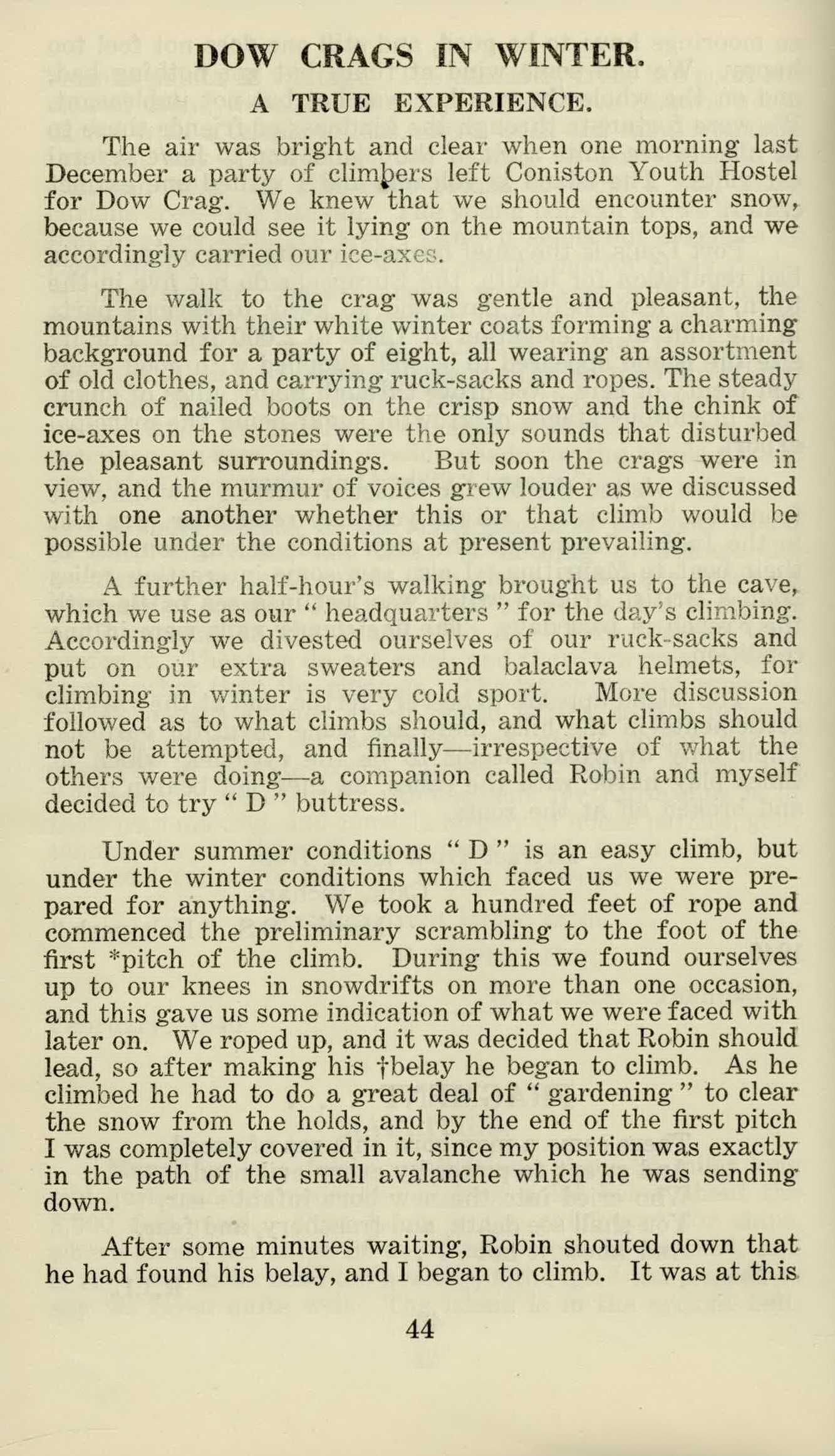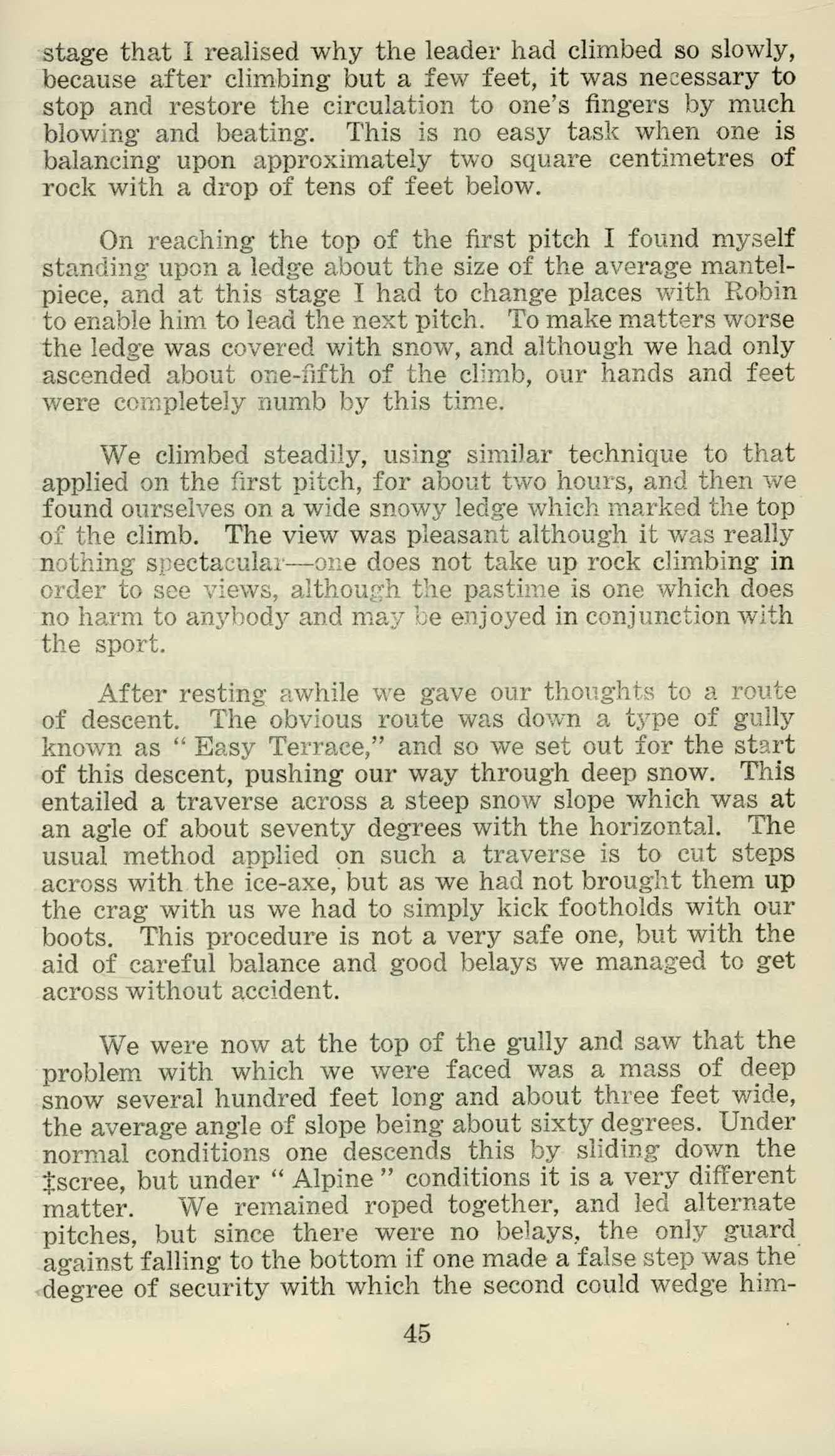
4 minute read
Dow Crags in Winter
from Jan 1941
by StPetersYork
A TRUE EXPERIENCE.
The air was bright and clear when one morning last December a party of climkers left Coniston Youth Hostel for Dow Crag. We knew that we should encounter snow, because we could see it lying on the mountain tops, and we accordingly carried our ice-axes.
The walk to the crag was gentle and pleasant, the mountains with their white winter coats forming a charming background for a party of eight, all wearing an assortment of old clothes, and carrying ruck-sacks and ropes. The steady crunch of nailed boots on the crisp snow and the chink of ice-axes on the stones were the only sounds that disturbed the pleasant surroundings. But soon the crags were in view, and the murmur of voices grew louder as we discussed with one another whether this or that climb would be possible under the conditions at present prevailing.
A further half-hour's walking brought us to the cave, which we use as our " headquarters " for the day's climbing. Accordingly we divested ourselves of our ruck-sacks and put on our extra sweaters and balaclava helmets, for climbing in winter is very cold sport. More discussion followed as to what climbs should, and what climbs should not be attempted, and finally—irrespective of what the others were doing—a companion called Robin and myself decided to try " D " buttress.
Under summer conditions " D " is an easy climb, but under the winter conditions which faced us we were prepared for anything. We took a hundred feet of rope and commenced the preliminary scrambling to the foot of the first *pitch of the climb. During this we found ourselves up to our knees in snowdrifts on more than one occasion, and this gave us some indication of what we were faced with later on. We roped up, and it was decided that Robin should lead, so after making his -belay he began to climb. As he climbed he had to do a great deal of " gardening " to clear the snow from the holds, and by the end of the first pitch I was completely covered in it, since my position was exactly in the path of the small avalanche which he was sending down.
After some minutes waiting, Robin shouted down that he had found his belay, and I began to climb. It was at this
44
stage that I realised why the leader had climbed so slowly, because after climbing but a few feet, it was necessary to stop and restore the circulation to one's fingers by much blowing and beating. This is no easy task when one is balancing upon approximately two square centimetres of rock with a drop of tens of feet below.
On reaching the top of the first pitch I found myself standing upon a ledge about the size of the average mantelpiece, and at this stage I had to change places with Robin to enable him to lead the next pitch. To make matters worse the ledge was covered with snow, and although we had only ascended about one-fifth of the climb, our hands and feet were completely numb by this time.
We climbed steadily, using similar technique to that applied on the first pitch, for about two hours, and then we found ourselves on a wide snowy ledge which marked the top of the climb. The view was pleasant although it was really nothing spectacular—one does not take up rock climbing in order to see views, although the pastime is one which does no harm to anybody and may be enjoyed in conjunction with the sport.
After resting awhile we gave our thoughts to a route of descent. The obvious route was down a type of gully known as " Easy Terrace," and so we set out for the start of this descent, pushing our way through deep snow. This entailed a traverse across a steep snow slope which was at an agle of about seventy degrees with the horizontal. The usual method applied on such a traverse is to cut steps across with the ice-axe, but as we had not brought them up the crag with us we had to simply kick footholds with our boots. This procedure is not a very safe one, but with the aid of careful balance and good belays we managed to get across without accident.

We were now at the top of the gully and saw that the problem with which we were faced was a mass of deep snow several hundred feet long and about three feet wide, the average angle of slope being about sixty degrees. Under normal conditions one descends this by sliding down the I:scree, but under " Alpine " conditions it is a very different matter. We remained roped together, and led alternate pitches, but since there were no belays, the only guard against falling to the bottom if one made a false step was the .degree of security with which the second could wedge him- 45










